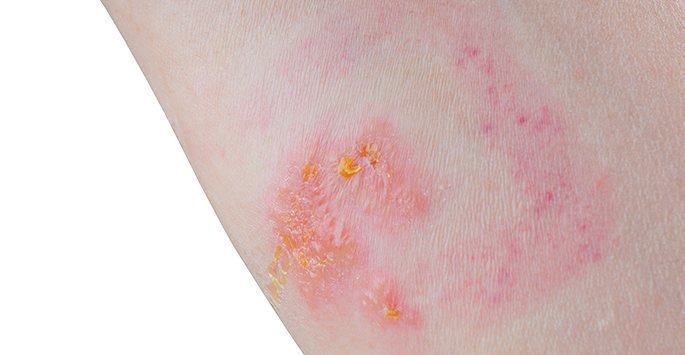

If you think you may be working around poison ivy, wear long sleeves, long pants tucked into boots, and gloves Wash your garden tools and gloves regularly.Remember the difference between the three leaves and keep an eye out when spending time outdoors.Even if blisters break, the fluid in the blisters is not plant oil and cannot further spread the rash.The plant oil lingers on virtually any surface until it is washed off with water It is possible to pick up the rash from plant oil that may have stuck to clothing, pets, garden tools, and other items that have come in contact with these plants.Poison ivy and other poison rashes can’t be spread from person to person.A rash can appear after a few hours, a few days, or even up to a week after exposure.If this is your first contact with urushiol, you may not see a rash at all.Here are a few extra facts to keep in mind should you encounter poison ivy, oak or sumac: Leaves are pointed and have smooth edges. Poison sumac has 7 to 13 leaves per stem, and it grows as a shrub or a small tree. Poison Sumac: This plant is often found in wooded, swampy areas, like the Southeastern and Northern US. These leaves have deep tooth-like edges around each leaf. Poison oak usually has three leaf, but sometimes up to 7 per leaf group. Oddly, it is rarely found in the Midwest region. Poison Oak: Poison oak is more common in Western US, and can appear in the Eastern US. Remember the age-old saying, “Leaves of three, let it be!” The leaves change colors depending on the season: red in spring, green in the summer, and yellow/orange in the fall. Poison ivy can grow on a vine or a shrub and is characterized by three spoon-shaped glossy leaves, with smooth or tooth-like edges. Poison Ivy: Common throughout the US, with the exception of Alaska, Hawaii, and parts of the West coast. Learn the differences between the three plants and what you can do to avoid contact and a resulting rash.

Poison ivy, oak, and sumac all have one thing in common: an oil found in the plants called urushiol. However, some species are especially dangerous and can irritate your skin. The argument can be made that all greenery found in the woods looks about the same – and we wouldn’t disagree with you.
WHAT DOES POISON IVY RASH LOOK LIKE HOW TO
Here’s how to tell the difference between poison ivy, poison oak, and poison sumac, and what to do if you get a rash from one of these plants.
WHAT DOES POISON IVY RASH LOOK LIKE SKIN
Rashes caused by poison ivy, poison oak, and poison sumac are a type of allergic contact dermatitis and can leave your skin feeling very itchy and irritated. It’s been a great summer season, but there are still more weekends and warm evenings ahead of us with outdoor activities, hiking, and camping.


 0 kommentar(er)
0 kommentar(er)
